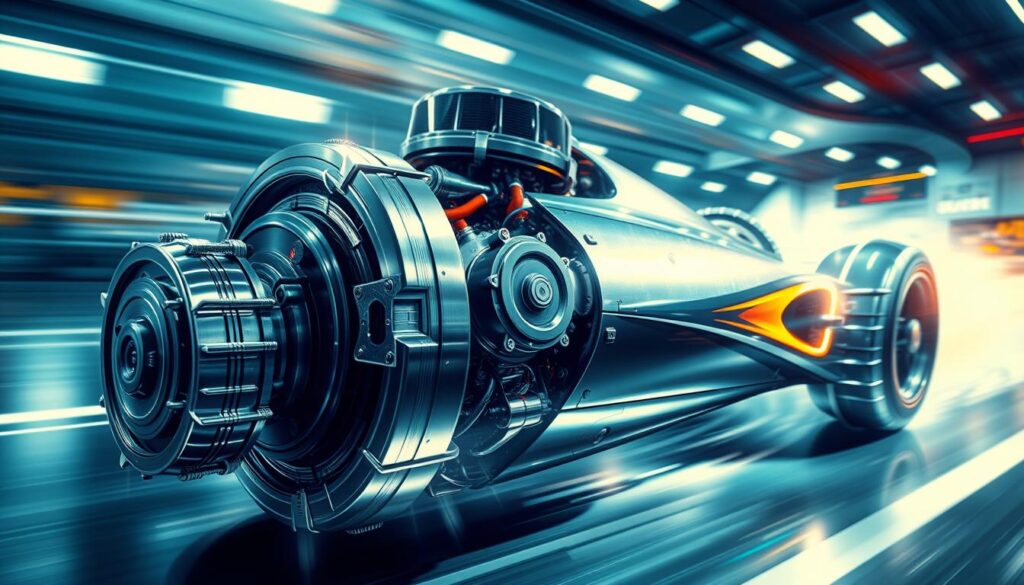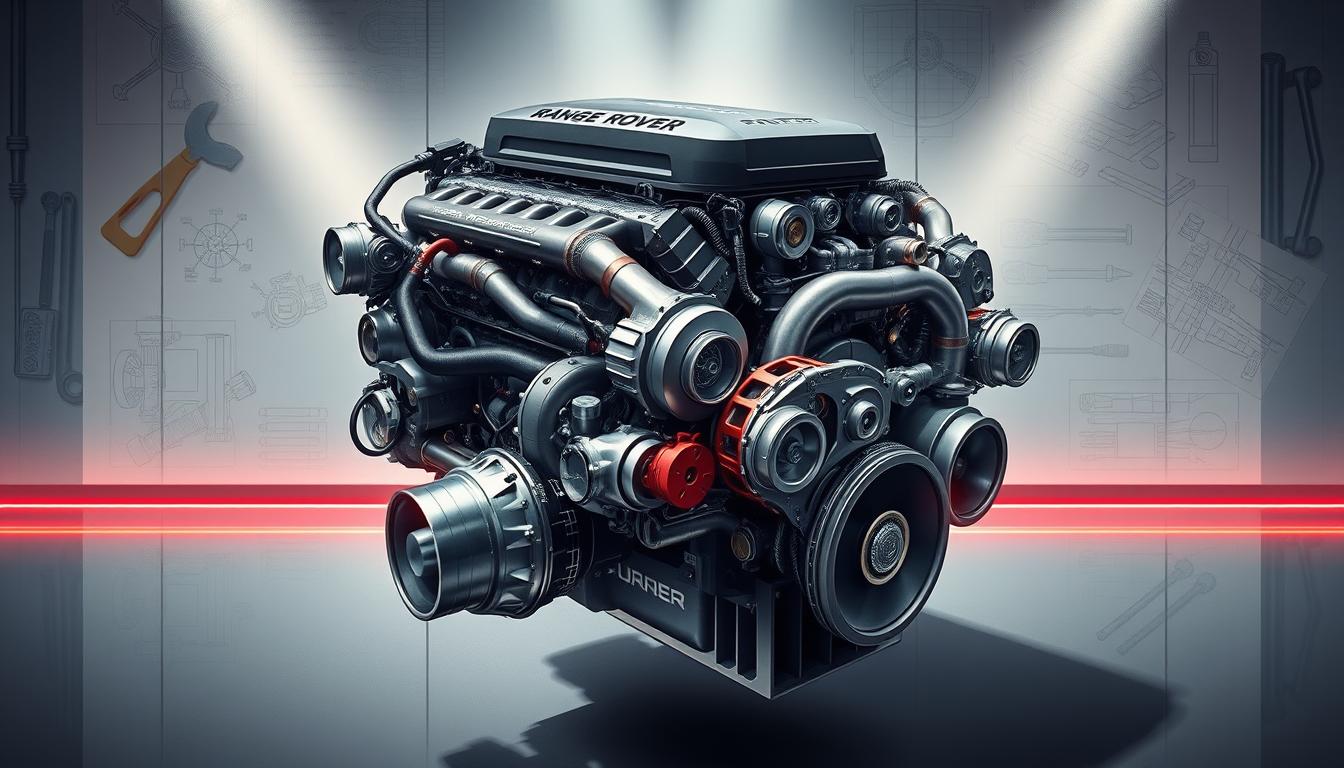
What’s the secret to getting the most out of your engine? High speed engine rpm is key. The global market for high-speed engines is huge, valued at US$ 19.83 billion in 2023. It’s expected to grow to US$ 32.26 billion by 2030, a jump of US$ 12.43 billion1.
Understanding high speed engine rpm is vital. It affects how well your engine runs, how long it lasts, and your car’s overall performance. The market is growing fast, with a 7.2% annual growth rate from 2023 to 20301.
We’ll look into what makes your engine perform well. The rise of gas turbines for power generation is boosting the market. The 500 kW – 1 MW power rating segment is leading the way1. Also, Asia Pacific’s demand for high-speed engines is expected to grow, thanks to China and India’s industrial activities2.
Key Takeaways
- High speed engine rpm is critical for optimal engine performance
- The global high-speed engine market size was valued at US$ 19.83 billion in 20231
- The market is expected to reach US$ 32.26 billion by 2030, resulting in an anticipated growth of US$ 12.43 billion1
- The high-speed engine market is driven by increasing adoption of gas turbines for power generation1
- Anticipated rising local demand for high-speed engines in Asia Pacific due to manufacturing and industrial activities in China and India2
- Adoption of predictive maintenance technology via AI improving reliability and efficiency in high-speed engines2
Understanding High Speed Engine RPM Fundamentals
Engine rpm, or revolutions per minute, is key to engine performance. Knowing how it works helps improve engine speed. The design of an engine’s gears affects its power, fuel use, and how well it performs.
Research shows that a special gear design is very efficient and covers a wide range of speeds3. This design is known for being compact and powerful.
What affects engine rpm includes its size, how it compresses air, and the camshaft design. The ratio of the sun gear to the planetary gear is important3. Also, the pressure in each cylinder can change a lot, and where the spark happens can shift by a few degrees4.
Engine speed is vital for performance. To get better fuel use and power, optimizing rpm is key. Here are the main things that influence engine speed:
- Engine displacement
- Compression ratio
- Camshaft design
- Gear ratio
Knowing how these elements work together is crucial for better engine performance. By studying rpm mechanics and engine speed, engineers can make engines more efficient. This leads to better fuel use and power3. Also, special camshaft designs help make all cylinders work equally well4.
In summary, grasping high-speed engine rpm basics is essential for better engine performance. By looking into rpm mechanics, engine speed, and the factors that influence it, engineers can create more efficient engines. These engines will use fuel better and have more power34.
The Science Behind Maximum Engine Speeds
Maximum engine speed is key to how well an engine performs. It’s about how fast the engine can go and still run well. This speed affects how much fuel it uses, how much power it makes, and how long it lasts5.
Things like the engine type, the fuel, and where it’s used all play a part. Knowing these can help make the engine run better.
Modern tech like turbocharging and hybrid engines have made engines better6. Turbocharging boosts power, and special turbochargers work better at high altitudes. Also, using waste heat can make engines more efficient, leading to better performance6.
In Formula 1, new V6 turbo-hybrid engines have made engines more efficient, with some over 50% efficient7. Energy Recovery Systems and materials like carbon fiber also help engines perform better and be lighter7.
By understanding engine speeds, engineers can make engines more efficient and powerful. This means better performance and longer engine life.
| Engine Type | Maximum Engine Speed | Thermal Efficiency |
|---|---|---|
| V8 Engine | 18,000 rpm | 40% |
| V6 Turbo-Hybrid | 15,000 rpm | 50% |
Critical Factors in High Speed Engine RPM: Insights and Analysis
High speed engine rpm involves several key factors. These include mechanical limits, material choices, and engineering hurdles. The North America high-speed engine market was worth US$ 5,996.80 million in 20228. This shows a big need for high-speed engines. To get the most out of high speed engine rpm, we must look at these factors and how they affect engine performance.
Material choices are very important for engine mechanics. The right materials can boost power, cut down on fuel use, and improve performance. For example, using lighter materials can make the engine more fuel-efficient and increase its speed9. The market size for high-speed engines is expected to hit US$ 36.28 billion by 20309. This growth shows the increasing need for high-speed engines and the importance of choosing the right materials.
Studying market trends and statistics helps us understand what affects high speed engine rpm. The global high-speed engine market includes many players like manufacturers, service providers, and users10. By looking at these trends, engine makers can design better high-speed engines. They can do this while keeping in mind mechanical and material limits.
In summary, high speed engine rpm is influenced by many factors. These include mechanical limits, material choices, and engineering challenges. By grasping these factors and their effects on engine performance, makers can create high-speed engines that are both efficient and powerful. This meets the growing demand for such engines.
Modern Technology and RPM Enhancement
Modern technology has greatly helped in improving engine performance. It allows engines to run faster and produce more power. RPM monitoring systems are key in making engines work better, by adjusting them in real-time. The torque converter market is growing fast, with a 5.20% annual growth rate from 2022 to 202911.
Research on engines has led to better understanding of how they work. It shows that the design of the combustion chamber is very important. Also, new transmission systems like CVT are making cars more efficient. The CVT market was worth USD 19.80 billion in 2021 and is expected to reach USD 31.56 billion by 202911.
Modern technology brings many benefits to engine performance. These include better efficiency, more power, and longer engine life. It also allows for real-time adjustments. This has changed the car industry, making engines more powerful and efficient. As technology keeps improving, we can look forward to even more advancements.
| Technology | Benefits |
|---|---|
| RPM monitoring systems | Real-time monitoring and adjustments |
| Optically accessible engines | Improved combustion efficiency and emissions |
| Continuously variable transmission (CVT) | Increased power output and engine longevity |
Impact of High RPM on Engine Longevity
High rpm can harm engine longevity by causing wear on engine parts12. The difference between actual and calculated combustion and emissions was small, showing good engine health12. It’s key to watch engine performance to avoid damage.
Keeping the engine in good shape is vital to avoid damage from high rpm13. The engine ran at 620 rpm and could produce 3310 kW at its best13. Also, starting issues were common if the engine wasn’t warm enough13.
To protect your engine, follow maintenance tips and watch for wear signs14. This helps keep the engine running well and saves money14. By doing this, you can make your engine last longer and avoid damage from high rpm.
| Engine Speed (RPM) | Wear Patterns | Maintenance Requirements |
|---|---|---|
| 620 | Piston ring wear | Regular oil changes |
| 1600 | Cylinder wall wear | Engine performance monitoring |
| 2200 | Valve train wear | Preventive maintenance |
Performance Tuning for Optimal RPM Ranges
Performance tuning is key for the best rpm ranges. This can greatly improve engine performance and efficiency. By fine-tuning gear changes, racing drivers can get a big edge. Knowing the best RPM shift points can save seconds in a race15.
Understanding torque and rpm is vital. The goal is to know the right gear for maximum torque at different speeds15. For example, 100 ft lbs of torque at 7000 RPM in 2nd gear changes with gearing and torque curve15. Adjusting gear ratios can boost acceleration and efficiency, crucial in racing16.
Performance tuning works for many racing cars or motorcycles with basic data15. It can greatly improve lap times, going beyond just feeling15. It also cuts energy use and maintenance costs, vital for electric motor users17.

In summary, tuning for optimal rpm ranges is vital for engine efficiency. By linking torque and rpm, and adjusting gears, drivers enhance speed and efficiency. This is critical in racing and useful for industries using electric motors151716.
Safety Considerations for High-Speed Operation
When you’re moving fast, keeping everyone safe is key. High speed operation needs a careful look at risks to avoid accidents. Data from Event Data Recorders (EDRs) shows that speed, braking, and seatbelts are very important18.
Doing a good risk assessment is vital. It means looking at data from EDRs to find out what causes accidents. For example, EDRs can show how speed and braking affect crashes18. Also, special tools and skills are needed to read EDR data, helping to make safety plans18.
Risk Assessment
Risk assessment is a big part of staying safe at high speeds. It’s about finding dangers, figuring out how likely they are, and how to avoid them. For high-speed driving, looking at EDR data helps understand what causes accidents and how to stop them18.
Protection Systems
Having protection systems is crucial for safety at high speeds. These can be things like airbags, seatbelts, and ABS. Data shows that using certain devices can make driving safer by reducing losses19.
Real-World Applications and Case Studies
High-speed engine RPM is key in racing for top performance and speed20. It’s also vital in industries for its efficiency and dependability21. Tests show high-speed engines boost power and cut down on fuel use22.
High-speed engines bring many benefits like more power, better fuel use, and less pollution20. Yet, they face issues like more wear and need for better cooling21. Still, they’re crucial in racing, aerospace, and cars22.
Studies prove high-speed engines work well in many areas, including
- Racing, where they help reach high speeds20
- Industries, for their efficiency and reliability21
- Testing, to check power and fuel use22
The table below highlights the good and bad sides of high-speed engines in real use:
| Application | Benefits | Challenges |
|---|---|---|
| Racing | More power, better fuel use20 | More wear on parts21 |
| Industrial | More reliable, less pollution21 | Need for cool systems22 |
| Performance Testing | Big boosts in power and fuel22 | Testing costs high20 |

Future Developments in High-Speed Engine Technology
The future of high-speed engine tech looks bright with new materials and tech that boost engine performance23. The global inboard engines market is set to hit USD 3.01 billion by 2034, up from USD 1.62 billion in 202423. This growth is fueled by the need for efficient and strong engines across many industries.
Advances include using lightweight composites and digital tech like RPM monitoring systems23. These changes will make engines more fuel-efficient, powerful, and last longer. Also, the market is moving towards greener options to cut down on greenhouse gas emissions24.
The high-speed engine market serves various sectors like power generation, marine, railway, and construction10. Companies are categorized by revenue, with Tier 1s making over USD 1 billion10. The market size and growth rate are forecasted using both top-down and bottom-up methods10.
| Market Segment | Revenue (USD billion) |
|---|---|
| Inboard Engines | 3.01 |
| High-Speed Engines | 1.62 |
The future of high-speed engine tech will be driven by the need for efficient and eco-friendly engines23. The market is expected to see significant growth, thanks to new materials and tech24. Keeping up with the latest trends and developments in high-speed engine tech is crucial10.
Conclusion: Mastering High-Speed Engine Performance
Mastering high-speed engine performance is a complex challenge. It requires a deep understanding of engine mechanics and advanced technologies. We’ve looked into the science and engineering behind these high-performance engines25.
Improving high-speed engines involves better materials, design, and control systems. New technologies like ultra-low viscosity oils and advanced engine management have boosted fuel efficiency and power25. Engineers are working hard to make these engines perform better and safer at high speeds.
The future of high-speed engine performance looks bright. New engine technologies and trends like electrification will lead to big improvements26. Being able to control engine parameters better and making engines more durable will be key. This will help meet the growing needs for efficiency, power, and safety in many fields.
To master high-speed engine performance, we must keep learning and using the latest technologies. By doing this, we can achieve new heights in engine performance. This will drive the industry forward and lead to even more impressive engineering achievements2526.
FAQ
What is the significance of high-speed engine RPM?
High-speed engine RPM greatly affects how well your car runs. It impacts fuel use, engine life, and overall car performance. Knowing about high-speed engine RPM is key to making your engine run better.
How do engine speed and RPM affect performance?
Engine speed is very important for how well your car performs. It affects how much fuel you use, how much power you get, and how long your engine lasts. Things like engine size, compression, and camshaft design also play a role.
What are the factors that affect maximum engine speeds?
Maximum engine speeds depend on several things. These include how engine speed affects performance. By optimizing engine speed, you can improve fuel use, power, and engine life.
What are the critical factors in high-speed engine RPM?
Important factors for high-speed engine RPM include mechanical limits, material choices, engineering rules, and performance limits. Understanding and dealing with these factors is key to better engine performance.
How can modern technology enhance RPM performance?
New tech, like RPM monitoring systems, can help improve engine RPM. This leads to better fuel use, power, and engine life.
What is the impact of high RPM on engine longevity?
High RPM can wear out engine parts like piston rings and valves. It’s important to maintain your engine well to keep it running at high RPM.
How can performance tuning be used to optimize RPM ranges?
Performance tuning, like engine mapping and fuel injection, can help optimize RPM. This improves fuel efficiency, power, and engine life.
What safety considerations are important for high-speed operation?
High-speed driving can be risky, leading to engine damage, accidents, and injuries. It’s vital to assess risks, use safety systems, and have emergency plans for safe high-speed driving.
Can you provide real-world applications and case studies for high-speed engine RPM?
High-speed engine RPM is used in racing, aerospace, and cars. Looking at real-world examples can show the benefits and challenges of high-speed engine RPM.
What future developments are expected in high-speed engine technology?
New materials and tech will likely improve engine performance. This could mean better fuel use, power, and engine life in the future.








